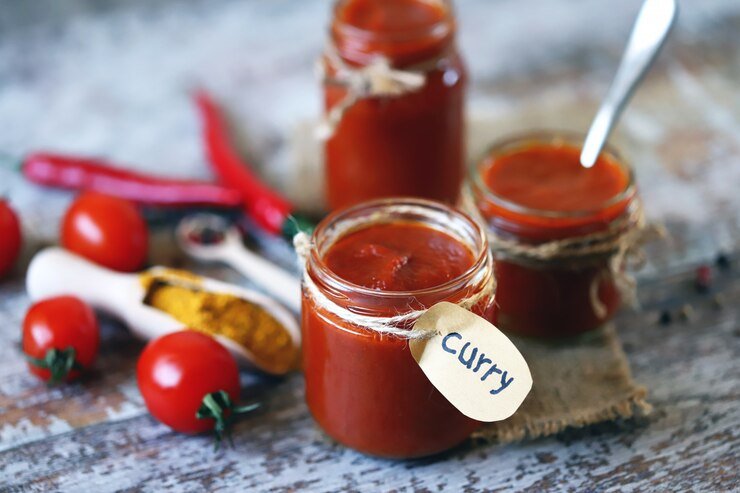Exploring the Elegant Term for Tomato Sauce
What is the fancy name for tomato sauce? Tomato sauce is more than just a culinary staple; it’s a cultural icon enjoyed worldwide. This versatile condiment, made primarily from tomatoes, varies greatly in flavor and usage from one culture to another. In Italy, it’s a heritage food, integral to traditional dishes like pasta and pizza. Elsewhere, it adapts to local tastes and ingredients, showcasing its global appeal.
This article will explore tomato sauce’s various names and the best tomato varieties for making it. We’ll dive into its rich history and cultural significance, revealing why tomato sauce is much more than just a simple kitchen ingredient. Through understanding its origins and variations, we’ll appreciate its role in culinary traditions around the world.
What is the fancy name for tomato sauce?
Definition and Uses
Tomato sauce is a versatile condiment made primarily from tomatoes that are cooked down into a rich, thick liquid. Often seasoned with herbs, spices, and other flavorings, it serves as a fundamental base for countless dishes in various cuisines around the world.
Historically, tomato sauce’s roots trace back to the indigenous peoples of Mexico, from where it spread to Europe and beyond. In its simplest form, it may consist only of tomatoes and salt, but regional variations introduce a diverse array of additional ingredients such as garlic, onions, basil, and oregano.
In Italian cuisine, tomato sauce forms the backbone of iconic dishes such as pasta, pizza, and lasagna. It provides moisture and a deep flavor base that complements other ingredients. In American kitchens, tomato sauce is the essential ingredient in barbecue sauces and chili. Meanwhile, in Indian and Middle Eastern dishes, it’s often seasoned with cumin, coriander, and turmeric, adding a robust flavor to curries and stews.
The versatility of tomato sauce makes it a global pantry staple, capable of adapting to the taste profiles of different culinary traditions. Its ability to blend with and enhance other flavors is what makes tomato sauce an indispensable ingredient in both home and professional kitchens.
The Fancy Name for Tomato Sauce
Discovering the Culinary Term
One of the more elegant terms often associated with tomato sauce is « Marinara. » This term, which resonates with a sense of culinary sophistication, actually has humble origins and a straightforward meaning. Originating from Italy, the word « Marinara » derives from « marinaro, » meaning sailor. Traditionally, it was a quick sauce prepared by sailors at sea using the basic ingredients they had on hand: tomatoes, garlic, and herbs.
Marinara sauce stands out from regular tomato sauce in its preparation and flavor profile. While basic tomato sauce can serve as a foundation or an ingredient in more complex sauces, Marinara is typically lighter, made with few ingredients, and cooked for a shorter period. It usually features tomatoes, garlic, fresh herbs, and sometimes includes olives or capers, emphasizing freshness and simplicity.
The distinctions between Marinara and other tomato sauces can also be seen in their usage. Marinara is often served with pasta, used as a dipping sauce for bread and appetizers, or as a base for other dishes like Parmigiana. Its simplicity and quick preparation time make it a favorite for home cooks and chefs who want to add a burst of flavor without the heaviness of more elaborately cooked sauces.
Best Tomato Varieties for Sauce
Top Choices for Homemade Sauce
Choosing the right tomato variety can significantly impact the flavor, texture, and quality of homemade tomato sauce. Here are some of the top varieties favored by chefs and home cooks alike for creating rich, flavorful sauces:
San Marzano
San Marzano tomatoes are often hailed as the gold standard for tomato sauce. Originating from the Campania region of Italy, these plum tomatoes are prized for their bright red color, firm pulp, low seed count, and sweet flavor, which balances the acidity perfectly. They have a thicker consistency and a higher solid content, making them ideal for a thicker, more concentrated sauce. The San Marzano’s peel also comes off easily, which is a desirable trait when making sauce as it simplifies the preparation process.
Roma
Roma tomatoes, also known as plum tomatoes, are another popular choice for sauces due to their dense, meaty flesh and few seeds. They cook down into a smooth, rich sauce with a deep tomato flavor. Romas are less watery than other varieties, which means they thicken up nicely without requiring lengthy cooking times to reduce excess liquid. Their robust nature and ability to hold flavor under heat make them versatile for both quick sauces and slow-cooked ones.
Heirloom Varieties
Heirloom tomatoes come in many shapes and sizes, each with unique flavors and textures. Some notable heirloom varieties for sauce include:
- Brandywine: Known for its large size and exceptional richness in flavor, which is both sweet and tangy.
- Amish Paste: A lesser-known variety that is gaining popularity for sauce due to its very meaty texture and sweet flavor.
- Black Krim: While not a traditional choice for sauce, it offers a unique, smoky flavor that can add depth to any sauce.
These tomatoes are generally less uniform than commercially bred types but are cherished for their superior flavor. Heirloom varieties often have a more complex taste profile, which can elevate a simple sauce into something extraordinary.
Jersey Giant
The Jersey Giant variety is a type of paste tomato that is becoming increasingly popular for sauces. It produces large, pear-shaped tomatoes that are perfect for canning and cooking. They have a rich flavor and, like the Roma and San Marzano, are less juicy and seedy, which makes them ideal for creating thicker, more flavorful sauces.
Costoluto Genovese
Costoluto Genovese is an Italian heirloom variety known for its deeply ribbed, almost scalloped shape, which is not only beautiful but also functional. The lobes make it easy to peel and core. The flesh is juicy yet firm, with a strong, tangy tomato flavor that becomes intensely richer when cooked, making it an excellent choice for sauces that require a bit of extra body and zest.
Choosing the right tomato for your sauce can transform a dish from ordinary to exceptional. Whether you opt for the renowned San Marzano, the reliable Roma, or an intriguing heirloom variety, each brings its unique qualities to the table, ensuring your homemade sauce is deliciously memorable.
How to Make Tomato Sauce
Step-by-Step Guide
Creating homemade tomato sauce is an art that combines simplicity with a touch of personal flair. Here’s a comprehensive guide to making your own delicious tomato sauce from scratch:
1: Selecting the Right Tomatoes
Choose fresh, ripe tomatoes for the best flavor. Varieties like San Marzano, Roma, or any heirloom tomatoes are ideal for sauces due to their rich flavors and meaty textures. Ensure the tomatoes are firm and free from bruises.
2: Preparing the Tomatoes
- Wash and Dry: Rinse the tomatoes under cold water and gently dry them.
- Peel the Skins (Optional): For a smoother sauce, you can peel the tomatoes. Make a small « x » on the bottom of each tomato and blanch them in boiling water for 20-30 seconds until the skins start to peel back. Then, plunge them in ice water and peel the skins off.
- Core and Seed: Remove the cores and, if desired, the seeds. Though seeding is optional, it can reduce the water content and make your sauce thicker.
3: Cooking the Sauce
- Ingredients: In addition to tomatoes, you’ll need olive oil, chopped onions, minced garlic, salt, pepper, and herbs like basil and oregano.
- Sauté the Aromatics: Heat a large pot over medium heat. Add olive oil, then sauté the onions until translucent. Add the garlic and cook until fragrant.
- Add Tomatoes and Seasonings: Add the prepared tomatoes, salt, and pepper. For a richer flavor, include a teaspoon of sugar to cut the acidity if needed.
- Herbs: Add fresh or dried herbs according to your preference.
4: Simmering
- Reduce Heat: Lower the heat to a gentle simmer. Let the sauce cook for at least 30 minutes, stirring occasionally. For deeper flavors, you can simmer the sauce for several hours, allowing the ingredients to meld together.
- Taste and Adjust: Taste your sauce periodically, adjusting the seasonings as needed. More salt, herbs, or a splash of wine can enhance the depth of flavor.
5: Blending (Optional)
For a smoother sauce, use an immersion blender to blend the sauce directly in the pot. Alternatively, you can let the sauce cool slightly and then transfer it to a blender or food processor.
6: Final Touches and Storage
- Final Seasoning: Adjust the seasoning if necessary and add fresh herbs like chopped basil for a fresh, vibrant finish.
- Cool and Store: Let the sauce cool completely if you plan to store it. Homemade tomato sauce can be kept in the refrigerator for up to a week or frozen in airtight containers for up to six months.
Homemade tomato sauce is not only a delightful addition to various dishes but also a great way to preserve the bounty of tomato season. With this guide, you can create a sauce that enhances any meal with the fresh, comforting essence of tomatoes.

Frequently Asked Questions
What is the difference between tomato sauce and marinara?
Tomato sauce and marinara are both made from tomatoes, but they serve different culinary purposes and are prepared differently. Tomato sauce is often cooked longer, resulting in a thicker consistency and is used as a base for other sauces and dishes. Marinara, on the other hand, is a quick-cooked sauce that typically includes garlic, onions, and herbs, and retains a fresher, brighter tomato flavor. It’s often used as a sauce for pasta or a dip for bread.
What are the best tomatoes for making sauce?
The best tomatoes for making sauce are those that are meaty with few seeds and have a robust flavor. Popular choices include:
- San Marzano: Known for their sweet flavor and low acidity, ideal for a balanced and smooth sauce.
- Roma: These are less juicy and have a dense flesh that makes them perfect for a thicker sauce.
- Heirloom Varieties: Such as Brandywine and Amish Paste, which offer a more complex flavor profile to the sauce.
Choosing the right tomato depends on the type of sauce you want to make and your flavor preferences.
How should I store homemade tomato sauce?
Homemade tomato sauce can be stored in the refrigerator or preserved for longer-term storage:
- Refrigeration: Keep it in an airtight container, and it should last for up to a week.
- Freezing: For longer storage, freeze the sauce in airtight containers or freezer bags. It can be kept frozen for up to six months. Be sure to leave some space at the top of the container as the sauce will expand when frozen.
- Canning: If you are experienced with canning, you can also can the sauce using a pressure canner, which allows you to store it at room temperature for up to a year.
These tips will help you maintain the freshness and flavor of your homemade tomato sauce, ensuring it’s ready to enhance your meals whenever needed.
Recommended Internal Links
- Link: Tomato Cream Sauce for Pasta
- Embed Phrase: « creamy variation of tomato sauce »
- Relevance: This link provides additional insights on a specific type of tomato sauce, offering readers further exploration into different styles of sauce preparation.
- Link: What is Creamy Tomato Pasta Called?
- Embed Phrase: « popular tomato pasta dishes »
- Relevance: This link directs readers to a page discussing various dishes that utilize tomato sauce, enhancing understanding of its culinary applications.
- Link: What is Tomato-Based Pasta Called?
- Embed Phrase: « traditional tomato-based pasta »
- Relevance: This link offers information on different kinds of tomato-based pasta, which can enrich the content’s scope by providing context and variations within the tomato sauce theme.
Unveiling the Rich History and Global Influence of Tomato Sauce
- Link: History of tomato sauce: Arab and Italian traditions
- Embed Phrase: « historical roots of tomato sauce »
- Relevance: This article provides an in-depth look at the historical development of tomato sauce in Arab and Italian cuisines, ideal for exploring its origins and cultural impact.
- Link: The Original Tomato Sauce
- Embed Phrase: « evolution of tomato sauce recipes »
- Relevance: This link offers insights into how tomato sauce recipes have evolved over the years, providing a historical perspective that complements discussions on the sauce’s versatility and adaptation.
- Link: Tomato Sauce and the Many Varieties of Multiculturalism
- Embed Phrase: « cultural significance of tomato sauce »
- Relevance: This article discusses the role of tomato sauce in various cultures and how it symbolizes multiculturalism, making it a perfect resource to highlight the global influence and adaptation of tomato sauce.
Conclusion: What is the Fancy Name for Tomato Sauce?
In conclusion, addressing the question, « What is the fancy name for tomato sauce? » reveals more than just a label; it uncovers a piece of culinary art known as « Marinara. » This term not only highlights the simplicity and richness of Italian cooking but also connects to deep cultural traditions. Using the term ‘Marinara’ instead of just tomato sauce can elevate a dish’s narrative, imbuing it with historical and gastronomic significance. Each time you refer to your sauce by this elegant name, you’re not just cooking — you’re celebrating a rich heritage. So, remember, when you’re making that sauce, you’re crafting something far beyond the ordinary: you’re making Marinara.


